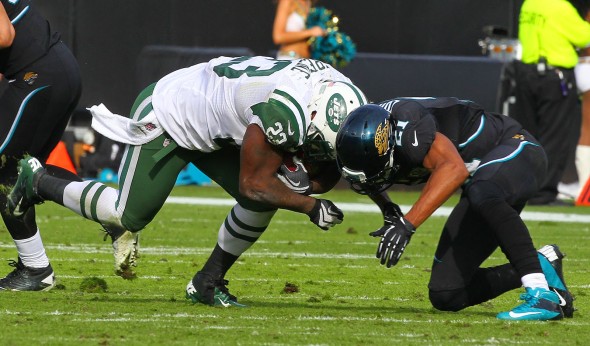redo Jump to...
print Print...
 NOTE:
NOTE:
- An actuary is a person who compiles and analyzes statistics and uses them to calculate insurance risks and premiums.
- An actuarial assumption (also called an assumption) is an estimate of an uncertain variable input into a financial model, normally for the purposes of calculating premiums or benefits.
(by Ken Belson, NY Times) – The National Football League, which for years disputed evidence that its players had a high rate of severe brain damage, has stated in federal court documents that it expects nearly a third of retired players to develop long-term cognitive* problems and that the conditions are likely to emerge at “notably younger ages” than in the general population. [*cognitive: of, relating to, or involving conscious mental activities (such as thinking, understanding, learning, and remembering)]
The findings are a result of data prepared by actuaries hired by the league and provided to the United States District Court judge presiding over the settlement between the NFL and 5,000 former players who sued the league, alleging that it had hidden the dangers of concussions from them.
“Thus, our assumptions result in prevalence rates by age group that are materially higher than those expected in the general population,” said the report, prepared by the Segal Group for the NFL “Furthermore, the model forecasts that players will develop these diagnoses at notably younger ages than the generation population.”
The statements are the league’s most unvarnished admission yet that the sport’s professional participants sustain severe brain injuries at far higher rates than the general population. They also appear to confirm what scientists have said for years: that playing football increases the risk of developing neurological conditions like chronic traumatic encephalopathy, a degenerative brain disease that can be identified only in an autopsy.
“This statement clears up all the confusion and doubt manufactured over the years questioning the link between brain trauma and long-term neurological impairment,” said Chris Nowinski, the executive director of the Sports Legacy Institute, who has for many years pressured the league to acknowledge the connection between football and brain diseases. “We have come a long way since the days of outright denial. The number of former players predicted to develop dementia is staggering, and that total does not even include former players who develop mood and behavior disorders and die prior to developing the cognitive symptoms associated with C.T.E.”
Greg Aiello, a spokesman for the NFL, declined to comment and referred questions to a lawyer representing the league, Brad Karp.
Karp said that the actuaries had based their findings on medical diagnoses reported by the players who sued the league, so the findings were inflated.
“The methodology was purposely designed to err on the side of overestimating possible injuries to ensure that adequate funds would be available to pay all awards, under the then-capped settlement structure,” Karp said in an email. “The actuaries’ models do not reflect a prediction of the number of players who will suffer injuries. They are intended to show the court that even if unexpectedly high numbers of players were injured, there still would be sufficient money to pay the claims.”
According to the assumptions compiled by the lawyers for the plaintiffs, about 28 percent of former players, totaling 5,900, will develop compensable injuries. Only about 60 percent, or 3,600, of those players are expected to file claims, which are estimated to total $950 million. Just over half of that money will be paid in the first 20 years, with the rest paid in the remaining 45 years of the settlement fund’s life.
The NFL’s actuaries assumed that 28 percent of all players would be found to have one of the compensable diseases and that the league would pay out $900 million to them. Their calculations showed that players younger than 50 had an 0.8 percent chance of developing Alzheimer’s or dementia, compared with less than 0.1 percent for the general population. For players ages 50 to 54, the rate was 1.4 percent, compared with less than 0.1 percent for the general population. The gap between the players and the general population grows wider with increasing age.
While the NFL actuaries based their assumptions on the medical conditions reported by the plaintiffs and used them to extrapolate* for the entire group of retired players, the plaintiffs’ lawyers first looked at rates of the diseases in the general population and compared them with those for NFL players. [*extrapolate is to form an opinion or to make an estimate about something from known facts]
For years, the NFL denied that there was a link between football and long-term neurocognitive conditions. As more studies, including one conducted by scientists at the University of North Carolina and another at the University of Michigan, found heightened rates of dementia and other cognitive decline in football players, the league softened its stance. “It’s quite obvious from the medical research that’s been done that concussions can lead to long-term problems,” Aiello, the NFL spokesman, said in 2009, the first time any league official had publicly acknowledged any long-term effects of concussions.
Abridged from a Sept. 12 NY Times report. Reprinted here for educational purposes only. May not be reproduced on other websites without permission from The New York Times.
Questions
1. a) What surprising admission did the NFL make in federal court?
b) Why was this admission surprising?
2. For what reason are 5,000 former players suing the NFL?
3. a) Define actuary.
b) What conclusion (assumption) did the actuaries hired by the NFL make about brain damage and NFL players?
4. How has the NFL responded to their own actuaries’ assessment?
5. The NFL’s actuaries and the players actuaries both concluded that 28% of players will develop compensable brain injuries. How did each come to this figure?
6. The NFL admits that one-third of retired football players develop long-term cognitive problems and that the conditions are likely to emerge at “notably younger ages” than in the general population. How does this affect your view of football?
Background
NOTE:
- An actuary is a person who compiles and analyzes statistics and uses them to calculate insurance risks and premiums.
- An actuarial assumption (also called an assumption) is an estimate of an uncertain variable input into a financial model, normally for the purposes of calculating premiums or benefits.
More from the NY Times article:
The actuarial numbers were released for the first time on Friday by the NFL and representatives of retired players who are suing the league. They formed the basis of the financial calculations used by both sides when they agreed last year to establish a pool of $675 million to cover injuries and diseases linked to head trauma that the players sustained during their careers.
The actuarial assumptions provide a window into an agreement that was widely criticized as insufficient to cover the costs of the claims and was rejected by the judge hearing the case.
The two sides used different methods to arrive at their estimates, but their final numbers were separated by a margin of only about 5 percent, at just under $1 billion in compensation. The $675 million originally set aside was considered sufficient by both sides because the fund would earn interest over the 65-year life of the settlement.
Concerns that the fund might run dry are largely moot now because the NFL agreed in June to pay an unlimited amount in awards to address concerns raised by the judge, Anita B. Brody of United States District Court in Philadelphia.
Still, the assumptions include some telling details. For those who file claims, the vast majority would be for players who received diagnoses of Alzheimer’s disease or advanced dementia. They would be expected to receive more than $800 million in awards.
The calculations show that both sides expected only several dozen former players to receive the largest monetary awards, up to $5 million for diagnoses of Parkinson’s disease, amyotrophic lateral sclerosis or C.T.E.
Resources
Chronic Traumatic Encephalopathy (CTE) is a progressive degenerative disease of the brain found in athletes (and others) with a history of repetitive brain trauma, including symptomatic concussions as well as asymptomatic subconcussive hits to the head. CTE has been known to affect boxers since the 1920s. Read more at: sportslegacy.org/research/cte
Daily “Answers” emails are provided for Daily News Articles, Tuesday’s World Events and Friday’s News Quiz.



